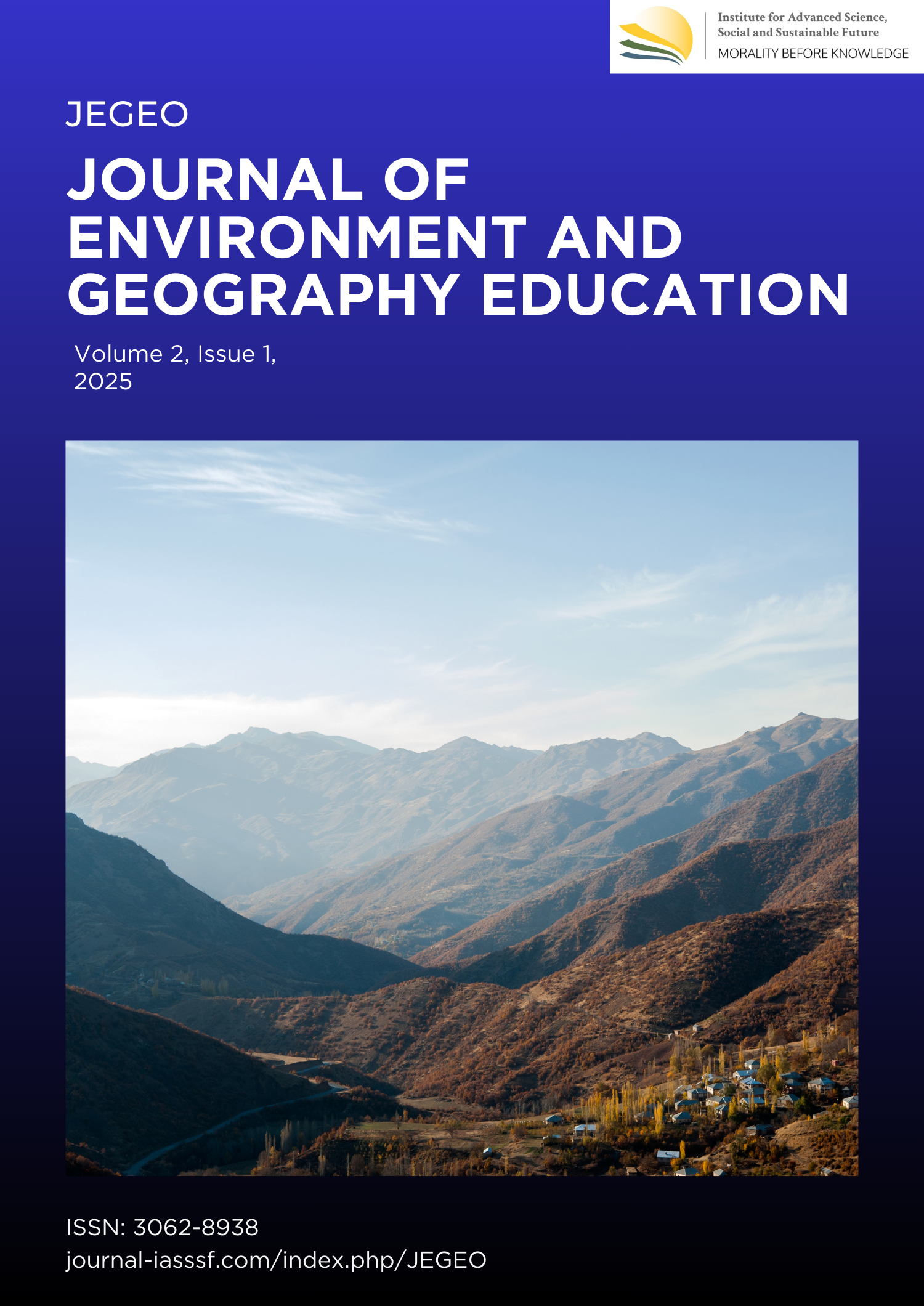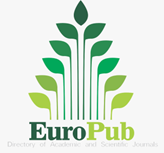KINA: Application of ecocentrism based learning to strengthen early forest care spirit through the tri hita karana value approach
DOI:
https://doi.org/10.61511/jegeo.v2i1.2025.1642Keywords:
children, tri hita karana, forestAbstract
Background: The transition from Gen Z to Gen Alpha has led to a shift in social activities, with children facing challenges from excessive device use, resulting in potential addiction and exposure to negative content. This issue is often rooted in inaccurate parenting methods. To address this, the value of Tri Hita Karana, which promotes harmony between humans, nature, and God, offers a potential solution. The KINA game application aims to mitigate these issues by incorporating this ancestral value while fostering climate action and forest awareness. Method: The study adopts a performance testing method with qualitative data quantification using scoring. The KINA game application integrates Ecocentrism Based Learning (EBL) within a pedagogical curriculum and utilizes User Interface (UI) and User Experience (UX) technology tailored for Gen Alpha. The implementation approach focuses on evaluating the effectiveness of the application in promoting climate action and forest awareness. Findings: The KINA game application successfully integrates the principles of Tri Hita Karana and Ecocentrism Based Learning (EBL), helping children develop an early awareness of environmental sustainability. The application demonstrates the potential to reduce device addiction while fostering a positive shift in social behavior among children, aligning with SDGs goals 4 (Quality Education), 13 (Climate Action), and 15 (Life on Land). Conclusion: The KINA application effectively addresses issues of device addiction and negative content exposure in children by promoting climate action and forest awareness. By integrating Ecocentrism Based Learning and Tri Hita Karana values, KINA offers a sustainable and educational solution to foster environmental consciousness from an early age. Novelty/Originality of this article: The KINA game application uniquely combines Ecocentrism Based Learning, Tri Hita Karana, and pedagogical curriculum design to educate children on climate action and forest awareness, offering a novel approach to parenting and digital education for the Alpha Generation.
References
Adiarsi, G. R., Putra, A. E., & Raymond, R. (2024). Motivation to Use Social Media among Gen-Z Students. Nomosleca Journal, 10(2), 269-279. https://doi.org/10.26905/nomosleca.v10i2.14603
Allan, H., Hollinshead, D., Rockwell, K., Ender, K., Antwi-Boasiako, K., O’Leary, D., ... & Fluke, J. (2025). Illuminating the complexity of decision making in child welfare using the decision making ecology: A scoping review. Children and Youth Services Review, 108121. https://doi.org/10.1016/j.childyouth.2025.108121
Allen, S., Cunliffe, A. L., & Easterby-Smith, M. (2019). Understanding Sustainability Through the Lens of Ecocentric Radical-Reflexivity: Implications for Management Education. Journal of Business Ethics, 154, 781-795.
https://doi.org/10.1007/s10551-016-3420-3
Anwar, R. K., Hadian, M. S. D., hendarmawan, H., & khadijah, U. L. S. (2020). Building Tourism from the Optimization of the Landscape as a Creative Economic Activity of the Community. Journal of Environmental Management and Tourism, 11(4), 937-953. https://doi.org/10.14505//jemt.11.4(44).18.
ArcGIS. (2024). ArcGIS software documentation. ESRI. https://www.arcgis.com
Aswani, S., Lemahieu, A., & Sauer, W. H. H. (2018). Global trends of local ecological knowledge and future implications. PLOS ONE, 13(4), e0195440. https://doi.org/10.1371/journal.pone.0195440
Bera, D., Chatterjee, N. D., Ghosh, S., Dinda, S., Bera, S., & Mandal, M. (2022). Penilaian kehilangan tutupan hutan dan dampaknya terhadap jasa ekosistem: penggabungan data penginderaan jauh dan persepsi masyarakat di hutan gugur kering di Benggala Barat, India. Jurnal Produksi Bersih, 356, 131763. https://doi.org/10.1016/j.jclepro.2022.131763
BNPB. (2021, December 31). Disaster Management Year-End Reflection Notes 2021. Badan Nasional Penanggulangan Bencana. https://bnpb.go.id/berita/catatan-refleksi-akhir-tahun-penanggulangan-bencana-2021
Cho, H. J., & Choi, N. (2025). Children's moral judgments and reasoning regarding environmentally harmful behaviors: Variation by victim type and moderation effect of connectedness to nature. Journal of Environmental Psychology, 101, 102475. https://doi.org/10.1016/j.jenvp.2024.102475.
Chodkowski, N., O’Grady, P. M., Specht, C. D., & Zamudio, K. R. (2022). Active Learning Strategies for Biodiversity Science. Frontiers in Education, 7. https://doi.org/10.3389/feduc.2022.849300
Contrino, M.F., Reyes-Millán, M., Vázquez-Villegas, P. & Membrillo-Hernández, J. (2024). Using an adaptive learning tool to improve student performance and satisfaction in online and face-to-face education for a more personalized approach. Smart Learning Environments, 11(6). https://doi.org/10.1186/s40561-024-00292-y
Faudzi, M. A., Cob, Z. C., Omar, R., Sharudin, S. A., & Ghazali, M. (2023). Investigating the user interface design frameworks of current mobile learning applications: A systematic review. Education Sciences, 13(1), 94. https://doi.org/10.3390/educsci13010094
Hidayat, A. R., Onitsuka, K., Sianipar, C. P., Basu, M., & Hoshino, S. (2023). To migrate or not to migrate: Internet use and migration intention among rural youth in developing countries (case of Malang, Indonesia). Digital Geography and Society, 4, 100052. https://doi.org/10.1016/j.diggeo.2023.100052.
Hu, J., Peng, C., Xu, Z., Cheng, J., Rong, F., Wang, Y., & Yu, Y. (2025). Childhood maltreatment and its dose-response relation with non-suicidal self-injury among adolescents: The mediating role of mobile phone addiction. Public Health, 239, 48-54. https://doi.org/10.1016/j.puhe.2024.12.027.
Johnson, C. C., & Czerniak, C. M. (2023). Interdisciplinary approaches and integrated STEM in science teaching. In Handbook of research on science education (pp. 559-585). Routledge.
Lee, I. J., & Huang, Y. C. (2024). Improving social skills in children with autism spectrum disorder using augmented reality and mixed reality technology combined with concept maps. Universal Access in the Information Society, 1-27. https://doi.org/10.1007/s10209-024-01135-w
Niman, E. M. (2019). Local wisdom and efforts to preserve the natural environment. Missio journal of education and culture, 11(1), 91-106. http://jurnal.unikastpaulus.ac.id/index.php/jpkm/article/view/754/345
Nurlia, A., Martin, E., Kaskoyo, H., Pieter, L. A. G., Palmolina, M., & Ulya, N. A. (2024). Symbiosis in the canopy: Unraveling the evolution and impact of Social Forestry in Lampung, Indonesia. International Journal of Design and Nature and Ecodynamics, 19(2), 541-552. https://doi.org/10.18280/ijdne.190220.
Pregoner, J. D. (2024). Research approaches in education: A comparison of quantitative, qualitative and mixed methods. IMCC Journal of Science, 4(2), 31-36. https://hal.science/hal-04655066/.
Rahiem, M. D. H. (2021). Storytelling in early childhood education: Time to go digital. International Journal of Child Care and Education Policy, 15(4). https://doi.org/10.1186/s40723-021-00081-x
Rahmayanti, H., & Ilyasa, F. (2022). Environmental Education and Climate Change. Selat Media.
Ribis, E. V. (2024). Fostering Sustainability Through Project-Based Learning: The Sustainable City Project, A Case Study in Primary Education. Ubiquity Proceedings, 4(1), 31. https://doi.org/10.5334/uproc.153
Sakr, A., & Abdullah, T. (2024). Virtual, augmented reality and learning analytics impact on learners, and educators: A systematic review. Education and Information Technologies, 29(15), 19913-19962. https://doi.org/10.1007/s10639-024-12602-5
Setiawati, Y., & Fithriyah, I. (2020). Early detection and treatment of gadget addiction in children. Airlangga University Press.
Schiele, T., Edelsbrunner, P., Mues, A., Birtwistle, E., Wirth, A., & Niklas, F. (2025). The effectiveness of game-based literacy app learning in preschool children from diverse backgrounds. Learning and Individual Differences, 117, 102579. https://doi.org/10.1016/j.lindif.2024.102579.
Shah, W. A., & Shah, U. R. (2025). De-centering the anthropocentric worldview in language textbooks: A posthumanist call for discursive reparations for sustainable ELT. Linguistics and Education, 86, 101397. https://doi.org/10.1016/j.linged.2025.101397.
Smith, P., Beaumont, L., Bernacchi, C. J., Byrne, M., Cheung, W., Conant, R. T., … & Long, S. P. (2022). Essential outcomes for COP26. Global Change Biology, 28(1), 1-3. https://doi.org/10.1111/gcb.15926
Snyder, H. (2019). Literature review as a research methodology: An overview and guidelines. Journal of business research, 104, 333-339. https://doi.org/10.1016/j.jbusres.2019.07.039
Syahriyah, U. U., & Zahid, A. (2022). Konsep Memanusiakan Alam dalam Kosmologi Tri Hita Karana. Panangkaran, 6(1), 1-23. http://ejournal.uin-suka.ac.id/pusat/panangkaran
Yang, Z., He, L., & Huang, T. (2024). Powering Pro-Environment Behavior: The Impact of Unlocking Reward Strategy on Pro-Environmental Behavior. Sustainability, 16(21), 9561. https://doi.org/10.3390/su16219561
Yli-Panula, E., Jeronen, E., Lemmetty, P., & Pauna, A. (2018). Teaching Methods in Biology Promoting Biodiversity Education. Sustainability, 10(10), 3812. https://doi.org/10.3390/su10103812
You, F., Liang, Y., Fu, Q., & Zhang, J. (2024). Exploring the Role of AR Cognitive Interface in Enhancing Human-Vehicle Collaborative Driving Safety: A Design Perspective. International Journal of Human-Computer Interaction, 1–21. https://doi.org/10.1080/10447318.2023.2295695
Yuan, X., & Tang, X. (2025). Effects of the sequential use of L1 and bilingual subtitles on incidental English vocabulary learning: A cognitive load perspective. British Journal of Educational Psychology. https://doi.org/10.1111/bjep.12740
Downloads
Published
Issue
Section
Citation Check
License
Copyright (c) 2025 Muhammad Khoirul Hasan, Esterlina Br Siregar, Muhammad Harun Rasyid Al Habsyi

This work is licensed under a Creative Commons Attribution 4.0 International License.















